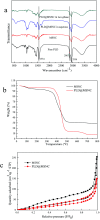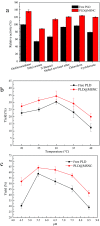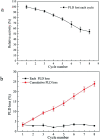Phospholipase D encapsulated into metal-surfactant nanocapsules for enhancing biocatalysis in a two-phase system
- PMID: 35518461
- PMCID: PMC9060939
- DOI: 10.1039/c8ra09827a
Phospholipase D encapsulated into metal-surfactant nanocapsules for enhancing biocatalysis in a two-phase system
Abstract
Methods for enhancing enzyme activities in two-phase systems are getting more attention. Phospholipase D (PLD) was successfully encapsulated into metal-surfactant nanocapsules (MSNCs) using a one-pot self-assembly technique in an aqueous solution. The highest yield for the production of high-value phosphatidylserine (PS) from low-value phosphatidylcholine (PC) in the two-phase system was achieved by encapsulating PLD into MSNCs formed from Ca2+ which gave an enzyme activity that was 133.6% of that of free PLD. The PLD@MSNC transformed the two-phase system into an emulsion phase system and improved the organic solvent tolerance, pH and thermal stabilities as well as the storage stability and reusability of the enzyme. Under optimal conditions, PLD@MSNC generated 91.9% PS over 8 h in the two-phase system, while free PLD generated only 77.5%.
This journal is © The Royal Society of Chemistry.
Conflict of interest statement
There are no conflicts to declare.
Figures







Similar articles
-
Phase-Specific Immobilization of Phospholipase D as an Efficient Pickering Emulsion Interfacial Catalyst for Converting Antarctic Krill Oil Phospholipid.ACS Appl Mater Interfaces. 2025 Jan 8;17(1):1834-1846. doi: 10.1021/acsami.4c14276. Epub 2024 Oct 18. ACS Appl Mater Interfaces. 2025. PMID: 39420812
-
Design of amino-functionalized hollow mesoporous silica cube for enzyme immobilization and its application in synthesis of phosphatidylserine.Colloids Surf B Biointerfaces. 2021 Jun;202:111668. doi: 10.1016/j.colsurfb.2021.111668. Epub 2021 Mar 1. Colloids Surf B Biointerfaces. 2021. PMID: 33740632
-
Highly active and stable nanobiocatalyst based on in-situ cross-linking of phospholipase D for the synthesis of phosphatidylserine.Int J Biol Macromol. 2018 Oct 1;117:1188-1194. doi: 10.1016/j.ijbiomac.2018.06.041. Epub 2018 Jun 15. Int J Biol Macromol. 2018. PMID: 29894783
-
Phospholipase D-mediated hydrolysis of phosphatidylcholine: role in cell signalling.J Lipid Mediat. 1993 Nov;8(3):177-82. J Lipid Mediat. 1993. PMID: 8268464 Review.
-
Phospholipase D as a catalyst: application in phospholipid synthesis, molecular structure and protein engineering.J Biosci Bioeng. 2013 Sep;116(3):271-80. doi: 10.1016/j.jbiosc.2013.03.008. Epub 2013 Apr 29. J Biosci Bioeng. 2013. PMID: 23639419 Review.
Cited by
-
Enzymatic preparation of glycerophosphatilcholine catalyzed by combinational phospholipases: a comparative study of concerted versus stepwise catalysis.RSC Adv. 2020 Oct 21;10(64):38727-38735. doi: 10.1039/d0ra07012b. eCollection 2020 Oct 21. RSC Adv. 2020. PMID: 35518402 Free PMC article.
References
-
- Khatoon H. Mansfeld J. Ulbrich-Hofmann R. J. Am. Oil Chem. Soc. 2016;93:365–372. doi: 10.1007/s11746-015-2784-3. - DOI
-
- Scillipoti J. Nioi C. Marty A. Camy S. Condoret J. S. Biochem. Eng. J. 2017;117:162–171. doi: 10.1016/j.bej.2016.10.012. - DOI
-
- Arca-Ramos A. Eibes G. Moreira M. T. Feijoo G. Lema J. M. Process Biochem. 2012;47:1115–1121. doi: 10.1016/j.procbio.2012.04.002. - DOI
-
- Bastida A. Blanco R. M. Zárate S. G. García-Junceda E. Guisán J. M. Biocatal. Biotransform. 2018;36:371–378. doi: 10.1080/10242422.2017.1326484. - DOI
-
- Zhong X. Qian J. Liu M. Ma L. Eng. Life Sci. 2013;13:563–571. doi: 10.1002/elsc.201200170. - DOI
LinkOut - more resources
Full Text Sources
Miscellaneous

